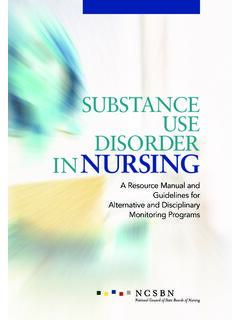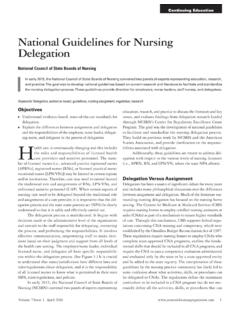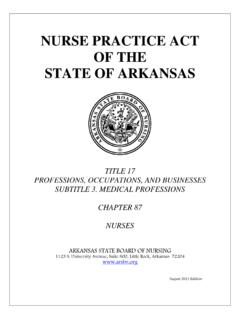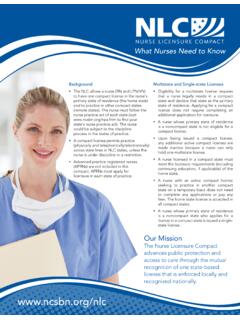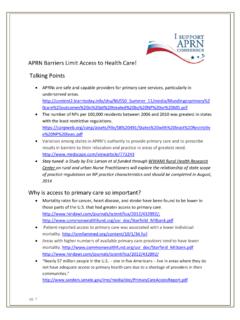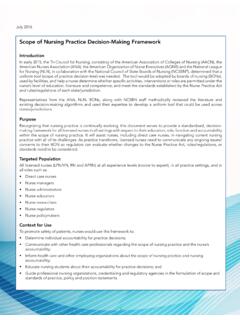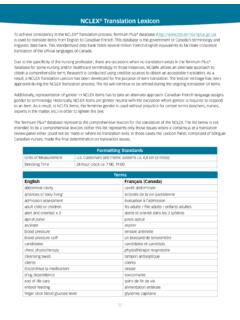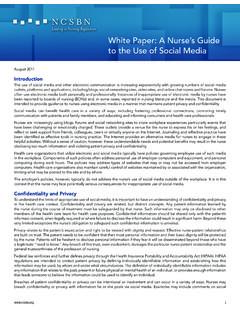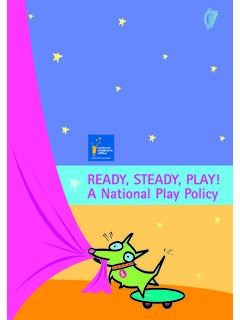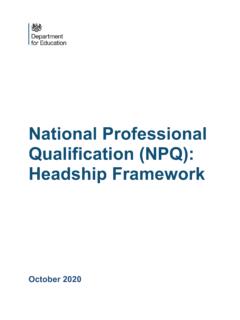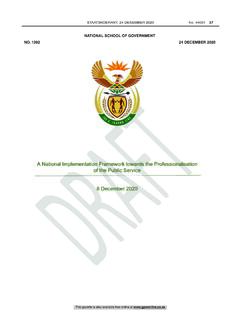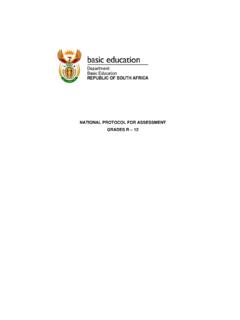Transcription of Nursing Faculty Qualifications and Roles - NCSBN
1 Council of State Boards of Nursing , Inc. 1 national Council of State Boards of Nursing ( NCSBN ) August 2008 NCSBN Faculty Qualifications Committee Brenda S. Jackson, PhD, MSN, RN D, MSN, RN, TX, Area III, Chair Duane Napier, MSN, RN, BC, WV PN, Area II Barbara Newman, RN, MS, MD, Area IV Susan Odom, PhD, RN, CCRN, ID, Area I Jessica Ressler, RNC, MSN, VA, Area III Sharon Ridgeway, PhD, RN, MN, Area II Linda Shanta, PhD, ND, Area II Nancy Spector, PhD, Director of Education BACKGROUND In response to questions being raised by legislators and stakeholders regarding Faculty Qualifications , in 2005-2006 NCSBN s Board of Directors charged the Practice.
2 Regulation and Education (PR&E) Committee to develop evidence-based Nursing education indicators. PR&E Committee members participated with NCSBN s Research Department to conduct the national Study of Elements in Nursing Education ( NCSBN , 2006b) and with NCSBN s Education Department to conduct a systematic review of Nursing education outcomes ( NCSBN , 2006c), for the purpose of developing evidence-based Nursing education guidelines for the boards of Nursing . Ultimately, the PR&E Committee presented Evidence-Based Nursing Education for Regulation, or EBNER ( NCSBN , 2006a), to the boards of Nursing .
3 The EBNER document explicitly describes, for the boards of Nursing , the published evidence that underpins Nursing education outcomes. As often occurs when research is conducted, further questions were identified. EBNER, which was an analysis of NCSBN s research and other published research, supported the need for qualified Faculty to guide and supervise student nurses. However, the question of what is meant by qualified Faculty ? then arose. At the same time, some Nursing programs were struggling to maintain their Faculty standards, as set by their boards of Nursing , because of the current Faculty shortage.
4 Programs were having problems attracting qualified Faculty , and lawmakers, in some states, were calling for a lowering of Faculty standards so that more Nursing students could be graduated. Yet, is lowering standards the answer? The Institute of Medicine (Greiner and Knebel, 2003, pp. 1-2) has called for an overhaul of health care education, stating that health professionals aren t adequately prepared, as it is, to address the ever-changing demands of health care. Similarly, the national Nursing Education Study of the Carnegie Foundation for the Advancement of Teaching has found that Nursing education classroom teaching suffers from a lack of adequate teaching in the areas of natural sciences, social sciences, and humanities.
5 (Benner, Sutphen, Leonard and Day, 2007) In this healthcare crisis, where medical errors annually kill more people than AIDS or breast cancer does (Kohn, Corrigan and Donaldson, 1999), neither the boards of Nursing , whose mission is public protection, nor educators, thought the answer was to lower standards. Therefore, the 2007-2008 NCSBN Board of Directors charged the Faculty Qualifications Committee with: Advising staff on content of Faculty Shortage Conference Nursing Faculty Qualifications and Roles Council of State Boards of Nursing , Inc.
6 2 Reviewing and presenting recommendations for future Faculty Qualifications and Roles . The committee members made their recommendations for future Faculty Qualifications and Roles after reviewing the following: Input from a collaborative conference call with representatives from the American Association of Colleges of Nursing (AACN), the Commission on Collegiate Nursing Education (CCNE), the national Association for Practical Nurse Education and Service (NAPNES), the national League for Nursing (NLN), and the national League for Nursing Accrediting Commission (NLN-AC).
7 There were 35 evidence-based articles and/or consensus statements by experts in Nursing education. Input from the speakers and participants of the Faculty Shortage: Implications for Regulation conference hosted by the committee members. Reports developed by 2006-2007 Practice, Regulation and Education (PR&E) Committee members, including the Faculty Shortage Survey and the Comparison of Faculty Qualifications in national Documents reports. Minutes from Education Consultant Network calls. Relevant surveys from the Education Consultant Network.
8 RECOMMENDATIONS A. Nursing Faculty in RN programs (full-time and part-time) shall have either a master s degree or a doctoral degree in Nursing . Their education should include graduate preparation in the science of Nursing , including clinical practice, and graduate preparation in teaching and learning, including curriculum development and implementation. Other supportive Faculty with graduate degrees in related fields may participate on a Nursing Faculty team to enrich and augment Nursing education. B. Nursing Faculty in PN programs (full-time and part-time) shall have either a master s degree or doctoral degree in Nursing .
9 Their education should include graduate preparation in the science of Nursing , including clinical practice, and graduate preparation in teaching and learning, including curriculum development and implementation. Other Faculty , BSN prepared, may participate on a Nursing Faculty team to enrich and augment Nursing education. C. Clinical preceptors shall be educated at or above the level for which the student is preparing. D. When boards of Nursing evaluate the preparation of Nursing Faculty members, it is essential to consider the three Roles of Faculty : collaborator, director of learning, and role modeling.
10 E. When boards of Nursing evaluate the preparation of Nursing Faculty members, they should assess processes of Faculty orientation. All part-time Faculty members, adjunct Faculty members, preceptors, novice Faculty members, and others, should be oriented to the Nursing program s curriculum and engaged in formal mentorships and Faculty development. F. Boards of Nursing are encouraged to collaborate with educators to foster innovation in Nursing education. PREMISES The Faculty Qualifications Committee members developed the following premises as a foundation for their recommendations: A.

